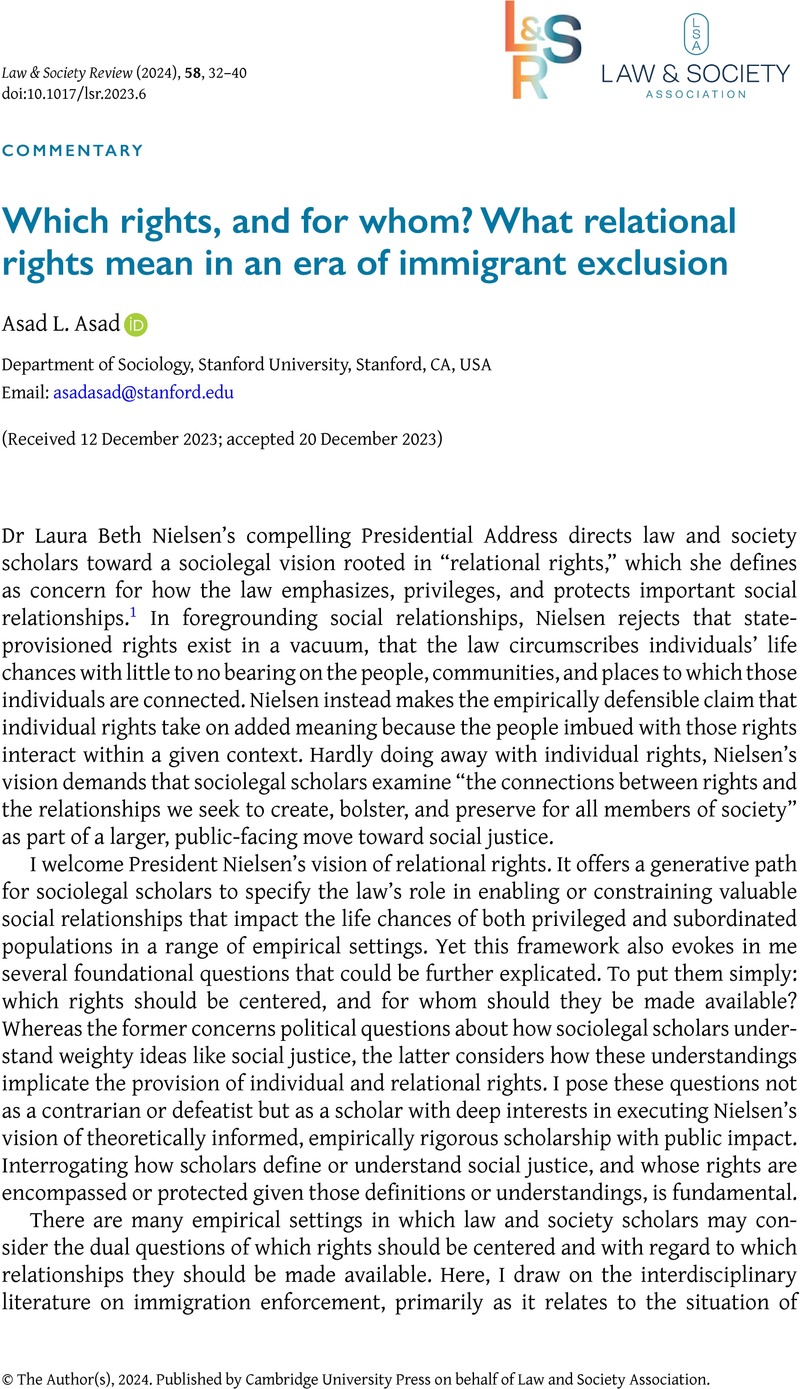No CrossRef data available.
Article contents
Which rights, and for whom? What relational rights mean in an era of immigrant exclusion
Published online by Cambridge University Press: 27 March 2024
Abstract
An abstract is not available for this content so a preview has been provided. Please use the Get access link above for information on how to access this content.

- Type
- Commentary
- Information
- Copyright
- © The Author(s), 2024. Published by Cambridge University Press on behalf of Law and Society Association.
References
Akbar, A. A. 2022. “Non-Reformist Reforms and Struggles over Life, Death, and Democracy.” Yale Law J. 132: .Google Scholar
Asad, A. L. 2019. “Deportation Decisions: Judicial Decision-Making in an American Immigration Court.” American Behavioral Scientist 63 (9): .CrossRefGoogle Scholar
Asad, A. L. 2020a. “Latinos’ Deportation Fears by Citizenship and Legal Status, 2007 to 2018.” Proceedings of the National Academy of Sciences 117 (16): .CrossRefGoogle ScholarPubMed
Asad, A. L. 2020b. “On the Radar: System Embeddedness and Latin American Immigrants’ Perceived Risk of Deportation.” Law & Society Rev. 54 (1): .CrossRefGoogle Scholar
Asad, A. L. 2023. Engage and Evade: How Latino Immigrant Families Manage Surveillance in Everyday Life. Princeton, NJ: Princeton University Press.Google Scholar
Berger, D., Kaba, M. and Stein, D.. 2017. “What Abolitionists Do.” Jacobin, August, 24 , 2017.Google Scholar
Bloemraad, I., Silva, F. and Voss, K.. 2016. “Rights, Economics, or Family? Frame Resonance, Political Ideology, and the Immigrant Rights Movement.” Social Forces 94 (4): .CrossRefGoogle Scholar
Calavita, K. 1992. Inside the State: The Bracero Program, Immigration, and the INS. New Orleans, LA: Quid Pro Books.Google Scholar
Carens, J. H. 1987. “Aliens and Citizens: The Case for Open Borders.” The Rev. of Politics 49 (2): .CrossRefGoogle Scholar
Clair, M. 2020. Privilege and Punishment: How Race and Class Matter in Criminal Court. Princeton, NJ: Princeton University Press.Google Scholar
Clair, M. and Woog, A.. 2022. “Courts and the Abolition Movement.” California Law Rev. 110: .Google Scholar
Davis, A. Y. 2016. Freedom Is a Constant Struggle: Ferguson, Palestine, and the Foundations of a Movement. Chicago, IL: Haymarket Books.Google Scholar
Eagly, I. V. and Shafer, S.. 2015. “A National Study of Access to Counsel in Immigration Court.” University of Pennsylvania Law Rev. 164: .Google Scholar
Fiorito, T. and Nicholls, W. J.. 2023. “Representational Hierarchies in Social Movements: A Case Study of the Undocumented Immigrant Youth Movement.” American J. of Sociology 129 (2): 485–529.CrossRefGoogle Scholar
Gamboa, S. 2023. “Undocumented Immigrants Here for Decades Ask Biden for Work Permits: Can It Be Done?” NBC News. https://www.nbcnews.com/news/latino/undocumented-immigrants-us-decades-ask-biden-work-permits-rcna125157 (accessed November 15 , 2023).Google Scholar
Garip, F. 2016. On the Move: The Changing Dynamics of Mexico-U.S. Migration. Princeton, NJ: Princeton University Press.CrossRefGoogle Scholar
Hainmueller, J. and Hopkins, D. J.. 2014. “Public Attitudes toward Immigration.” Annual Rev. of Political Science 17: .CrossRefGoogle Scholar
Hausman, D. K. 2022. “The Unexamined Law of Deportation.” Georgetown Law J. 110: 973–1020.Google Scholar
Kaba, M. 2021. We Do This’ Til We Free Us: Abolitionist Organizing and Transforming Justice, Vol. 1. Chicago, IL: Haymarket Books.Google Scholar
Kim, S. M. and Yellow Horse, A. J.. 2018. “Undocumented Asians, Left in the Shadows.” Contexts 17 (4): 70–71.CrossRefGoogle Scholar
Koh, J. L. 2021. “Downsizing the Deportation State.” Harvard Law & Policy Rev. 16: 85–113.Google Scholar
Lai, T., Hoffmann, N. I. and Waldinger, R.. 2023. “When Fear Spreads: Individual-and Group-level Predictors of Deportation Worry among Latino Immigrants.” J. of Ethnic and Migration Studies 49 (11): .CrossRefGoogle Scholar
Masferrer, C., Hamilton, E. R. and Denier, N.. 2019. “Immigrants in Their Parental Homeland: Half a Million US-born Minors Settle Throughout Mexico.” Demography 56 (4): .CrossRefGoogle Scholar
Massey, D. S., Durand, J., and Malone, N. J.. 2002. Beyond Smoke and Mirrors: Mexican Immigration in an Era of Economic Integration. New York, NY: Russell Sage Foundation.Google Scholar
Massey, D. S., Durand, J. and Pren, K. A.. 2016. “Why Border Enforcement Backfired.” American J. of Sociology 121 (5): .CrossRefGoogle ScholarPubMed
Menjívar, C. and Abrego, L.. 2012. “Legal Violence: Immigration Law and the Lives of Central American Immigrants.” American J. of Sociology 117 (5): .CrossRefGoogle Scholar
Migration Policy Institute. 2018. Profile of the Unauthorized Population: United States. Washington, DC: Migration Policy Institute.Google Scholar
Oliphant, J. B. and Cera, A.. 2022. Republicans and Democrats Have Different Top Priorities for US Immigration Policy. Washington, D.C: Pew Research Center.Google Scholar
Passel, J. S. and Woodrow, K. A.. 1987. “Change in the Undocumented Alien Population in the United States, 1979-1983.” International Migration Rev. 21 (4): .Google ScholarPubMed
The White House House. 2014. “Remarks by the President in Address to the Nation on Immigration.” https://obamawhitehouse.archives.gov/the-press-office/2014/11/20/remarks-President-address-nation-immigration (accessed November 15 , 2023).Google Scholar
Warren, R. 2021. “In 2019, the US Undocumented Population Continued a Decade-long Decline and the Foreign-born Population Neared Zero Growth.” J. on Migration and Human Security 9 (1): 31–43.CrossRefGoogle Scholar
Waldinger, R., Hoffmann, N. I., and Lai, T.. 2023. “Differentiated Legality: Understanding the Sources of Immigrants’ Deportation Fear.” Ethnic and Racial Studies.Google Scholar
Yazdiha, H. 2023. The Struggle for the People’s King: How Politics Transforms the Memory of the Civil Rights Movement. Princeton, NJ: Princeton University Press.Google Scholar



